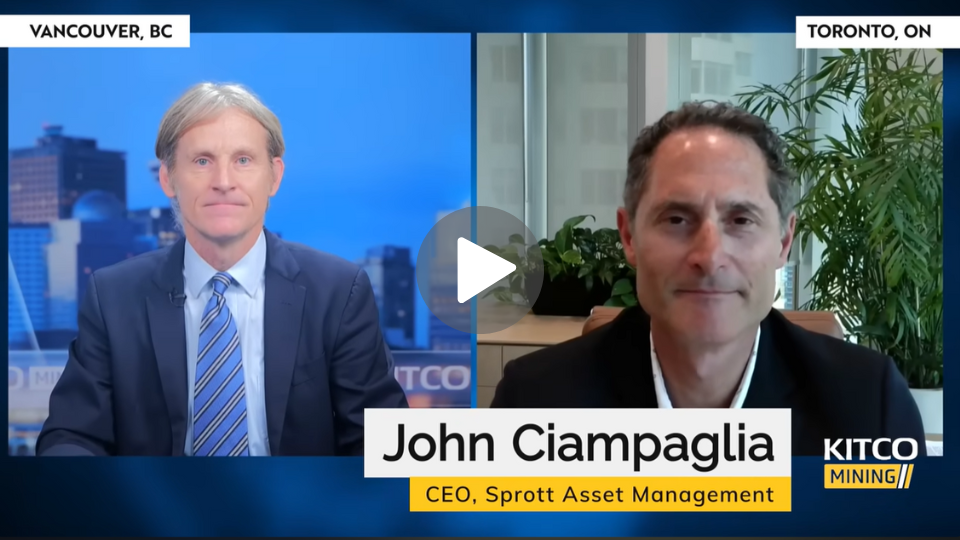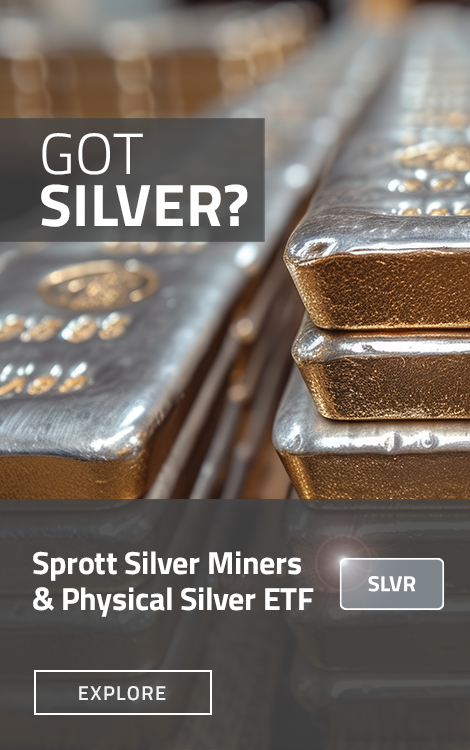August 26, 2024 | 16 mins 25 secs
Silver prices should spike higher with gold hitting a new all-time high above $2,500 an ounce, said John Ciampaglia, CEO of Sprott Asset Management, when speaking with Kitco Mining. “It's mind-boggling to us that silver is still below $30. It is obviously way off its 2010 highs, and we would love to see it get back to the $50 level,” said Ciampaglia. “We think it has the ability to do that over time.”
Video Transcript
Michael McCrae: It's a pivotal fall with the Fed set to cut and elections less than three months away. How does that all affect metals? John Ciampaglia is the CEO of Sprott Asset Management. John, welcome back to KITCO.
John Ciampaglia: Thank you for having me back.
Michael McCrae: Let's start with a macro picture, John. What key economic data are you watching? We had labor and inflation data that would push the Fed to cut.
John Ciampaglia: I think everything has been about inflation for about two years. The Fed patiently waits to cut interest rates and start the easing cycle. They seem to be completely fixated on inflation. That's their primary objective that they want to slay. If the economy softens, which it is currently doing, I think that is an acceptable trade-off they will make. That's not great for the average person out there, but inflation seems to be their primary focus—wanting to get it back to this magical 2% number. It's been very stubborn in terms of coming down. I think we're starting to finally see relief in terms of a lot of pricing pressure coming out of the economy on both the goods and services side. I think we're cautiously optimistic that the Fed will finally cut rates. Market expectations are right now for a number of cuts for the balance of 2024, with potentially another 100 basis points next year.
That will greatly relieve the economy and help bolster many precious metals.
Michael McCrae: Are you in the hard or soft-landing camp, John?
John Ciampaglia: I don't think I'm in any camp. I think I'm in the stall camp, which means the economy will not likely hit a hard landing unless there's calamity or a financial disruption. But I think it's more of a situation of the economy stalling, which means it's not growing. That seems to indicate from much of the recent data that we're just not getting much growth. Remember, a recession is technically two consecutive quarters of economic contraction. We haven't quite seen that. The Canadian economy is softer than the U.S. economy, but you're starting to see signs that the consumer is tapped out. They're stressed out.
You're starting to see people cutting back on corporate earnings and everyday items. In the U.S., people have the luxury of having a 30-year fixed mortgage. We don't have that in Canada. As the mortgage book renews over the next 24 months, it will be a very difficult reset for many people.
It's the number one cost item in their day-to-day lives, people with mortgages. If the Bank of Canada does not follow suit aggressively, we could see potentially negative quarterly growth in Canada.
Michael McCrae: Let's turn to gold and metals, John. Gold, of course, has hit several all-time highs, but it's been a bit of an unusual move. In a recent Sprott blog post, you noted that gold's rise has been driven by central bank buying and Asian demand. We're still waiting for Western investors to turn their attention to gold, correct?
John Ciampaglia: It's been an odd market since October. We've had this stealth rally, and it's been grinding higher. I should note that gold has hit all-time record highs in almost every currency in the world, and the U.S. dollar was the last to go. But gold has been incredibly resilient in every currency, with the lack of Western investors for most of the rally we've seen since October. The good news is that in the month of July, we saw a real rebound, and what we follow in terms of that indicator as we look at inflows into gold ETFs globally. After having a very soft Q1, July was an actual breakout month.
We've seen that in our own business as well. We had a strong rebound in our metal sales at Sprott. In August, we've seen continued strength. I think Western investors are starting to take notice now. Why have they finally started to wake up? They're becoming increasingly concerned about potential market disruptions because they're still concerned about whether the Fed is a little behind the curve in terms of cutting rates. There's a lot of U.S. political risk and wars potentially expanding in the Middle East. Everyone is thinking more cautiously about having some of that insurance in their portfolio. We see that finally trickling into gold ETF inflows, which are very institutionally driven.
Michael McCrae: Speaking of noticing gold, John, the gold miners are supposed to be leveraged to gold. Still, I see the Gold Miner Index to GDX is up about 21% this year, and we've already had many of the Q2s come out. That's not far off physical gold, up about 18% to date (August 14). What's going on?
John Ciampaglia: We always like to remind people that gold as a portfolio insurance1 or an alternative currency plays a very different role in a portfolio than gold stocks. Gold stocks have leveraged the price of gold but have a moderate correlation to stock. If the stock market were to crash tomorrow, gold stocks in the short term would fall, and gold probably would too, because people would be cashing in their insurance and finding easy liquidity. However, gold stocks have been very frustrating to a lot of investors, including ourselves. I chalk it up to lack of institutional interest, and we talk to institutional investors around the globe. At Sprott, we're very active, and I'd say they're just not paying attention right now, or at least until the last six weeks. They aren't paying attention to gold stocks, even though the results have been very good for many miners. We're starting to see some interesting M&A, which is always a good sign that interest is returning to the sector.
They represent good values, and I think they'll probably be behind the curve regarding institutional interest. As I said, gold inflows in the ETFs have just picked up in the last six weeks, and I'd like to see that translate into stronger inflows for the gold mining ETFs.
Michael McCrae: Thoughts on M&A, John? We saw Anglo take out Osisko and its Windfall Project for $1.6 billion in cash. People seemed to paint the deal as bullish. An investor's note said the amount of cash put in the transaction was a "surprise." Maybe this is another good sign that we're seeing a bit of recovery in the resource space, John?
John Ciampaglia: I think a number of mining companies are attractive takeover targets because they haven't performed well. What we see, not just in gold but in the copper space, is that it's often more attractive to buy a mine or a mine being built than it is to build one. This is just because the cost inflation in the mining sector has been very high over the last few years. It's starting to level out, but it's very attractive to buy these assets if they're high-quality assets in good jurisdiction. We would expect this M&A trend to continue. We've seen it obviously in the copper sector. Everyone strategically tries to position themselves and bulk up, mainly because of liquidity. Liquidity is so important today, particularly within institutional investors, that bigger is better. Again, I don't think this is an exercise in mining companies buying other mining companies just to be bigger, as they did in the last cycle, which turned out to be somewhat disastrous. But I think it's about strategically finding the right assets to improve scale and diversify.
Michael McCrae: What developments are you watching with de-dollarization in BRICS2?
John Ciampaglia: I think the most interesting thing is what the Central Bank of China is doing. China was buying enormous amounts of gold over the fall and the first quarter when institutional investors in the West weren't paying attention. Then it's interesting to us that they've signaled they bought no additional gold in the last three months. I think it's a bit of a classic move by the Chinese. When a commodity price gets high, they love to message the market, talk it down or walk away. We've seen them do this in copper, lithium and cobalt.
They love to talk the market down when they strategically want to buy more, which can be effective. Putting aside the last three months where they've sat on the sidelines, I think the trend is only one way: China is recycling all their U.S. treasuries into hard assets like gold. We would expect them to resume their buying. It's inevitable. I think the Central Bank of China is going to do that. Individual investors are returning to gold in China after the real estate market has soaked up a lot of savings in China in the last few years. I think it's fair to say that the real estate bubble in China has finally popped. Much capital is looking for alternatives, and gold is near and dear to Chinese investors.
Michael McCrae: John, how does silver look? Now, when gold moves, silver is supposed to pop. But in another interview, you said that the demand picture for silver is mixed with industrial and precious metal demand.
John Ciampaglia: Silver is performing quite well this year, and it's doing its thing, which is starting to rally past gold. It's been very volatile, for sure. We've had a lot of days where we've had 3%, 4%, 5% daily moves. That's interesting to us. Remember, institutional investors do not generally prefer silver as a portfolio hedge; it tends to be more speculative. Central banks don't buy silver because of the challenges of storing big dollar amounts. However, steady industrial applications have underpinned silver, mostly in the solar space. China is flooding the world right now with very cheap solar panels. I think it's fair to say there's overcapacity. They don't care if they're producing these things at very low margins, which consumes a lot of silver.
We expect upwards of 20% of silver to go to PV's3. If you take a step back, we think silver remains incredibly cheap. It's mind-boggling for us that silver is still below $30. It is way off its 2010 highs, and we would love to see it return to $50. We think it can be done over time.
Michael McCrae: Speaking of energy transition, I think one of the biggest stories I've seen in mining is copper right now. Goldman Sachs called it the new oil a few years ago.
John Ciampaglia: Copper had a standout period at the beginning of the year. It's pulled back about 20%. It got a little overheated, and once again, the Chinese signaled the price was too high, and they destocked and helped the price come down. The price and the copper market are very constructive in the long term. I think it's very reflective of some of the M&A activity that's happening in the sector over the last couple of years. The big mining companies are very focused on building up their reserves of copper. They see what's going on with this energy transition and how copper-intensive it will be. It's everything from electric vehicles to solar, wind farms, and air conditioning. But it's being driven by very basic things, like people in India buying air conditioners for the first time, increasing the amount of energy consumption per capita. Many places in the world still use a fraction of electricity. We need massive build-out of grid transmission, which is all very copper intensive. Long term, I think it's very constructive.
Once again, companies focus on buying assets rather than building them. The reason for that is quite simple. The current copper price does not add an incentive level to justify the usual multi-billion dollar upfront investments to build new copper mines. Everyone is focused on buying versus building. Eventually, when the price, I think, hits $5 a pound, we'll see more shovels in the ground and more mine expansions. But it's increasingly difficult to mine copper. A lot of the legacy deposits and mines are getting old. Grades have fallen, and we're finding copper at much higher elevations in the Andes, which require many more challenges, particularly bringing water up to 4,000 and 5,000 meters above sea level. Copper is constrained on the supply side. We see a growing interest in these new technologies and a general push for more electricity.
Michael McCrae: Lastly, John, the classic trade in commodities is positioning yourself in the metal everyone hates. Would that be nickel, lithium, or iron? What's your favorite contrarian play, John?
John Ciampaglia: They're all struggling right now due to overcapacity. China is a classic case where they're flooding the market with steel. There's way too much steel. The real estate sector there has cooled off, leading to a glut. Lithium is struggling here to find a bottom as EV sales are moderating. EV sales are still quite good, but they've calmed down in terms of percentage growth over the last few months. Nickel is another example of how we've just got too much production coming out of Indonesia again, with sponsorship largely from Chinese companies. But I'd say all three of those metals still don't look bullish to us right now. They still need to find some equilibrium. We're starting to see announcements of nickel mines closing and lithium production being curtailed. We will need more lithium in the long term, but there's a short-term imbalance.
However, in the short term, one other metal that is a little out of favor would be uranium. I say that because the price got to $106 a pound in January, we're currently at $81. We've made healthy corrections and think that in the back half of this year, we will see a better uranium market. That's something that, again, it's not hated, but I think it's somewhat out of love in the short term, and we think we'll see better days for uranium.
Michael McCrae: John, thank you for your time.
John Ciampaglia: Thanks for having me. It's great to see you.
Michael McCrae: My name is Michael McCrae. You're watching KITCO Mining.
| 1 | Gold and other precious metals may be referred to as “portfolio insurance”, a “store of value”, “safe haven”, “safe asset” and a variety of synonymous terms and phrases. These terms of art commonly used in precious metals investing do not guarantee, explicitly or implicitly, any form of investment safety. While “safe” assets like gold, Treasuries, money market funds, and cash—relative to others—typically do not carry a high risk of loss across all types of market cycles, there is no safety in any investment class and any asset class may lose value, including the possible loss of invested principal. |
| 2 | BRICS is an intergovernmental organization comprising Brazil, Russia, India, China, South Africa, Iran, Egypt, Ethiopia, and the United Arab Emirates. |
| 3 | A photovoltaic (PV) cell, commonly called a solar cell, is a nonmechanical device that converts sunlight directly into electricity. Some PV cells can convert artificial light into electricity. |
Investment Risks and Important Disclosure
Relative to other sectors, precious metals and natural resources investments have higher headline risk and are more sensitive to changes in economic data, political or regulatory events, and underlying commodity price fluctuations. Risks related to extraction, storage and liquidity should also be considered.
Gold and precious metals are referred to with terms of art like "store of value," "safe haven" and "safe asset." These terms should not be construed to guarantee any form of investment safety. While “safe” assets like gold, Treasuries, money market funds and cash generally do not carry a high risk of loss relative to other asset classes, any asset may lose value, which may involve the complete loss of invested principal.
Past performance is no guarantee of future results. You cannot invest directly in an index. Investments, commentary and opinions are unique and may not be reflective of any other Sprott entity or affiliate. Forward-looking language should not be construed as predictive. While third-party sources are believed to be reliable, Sprott makes no guarantee as to their accuracy or timeliness. This information does not constitute an offer or solicitation and may not be relied upon or considered to be the rendering of tax, legal, accounting or professional advice.




